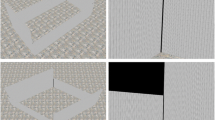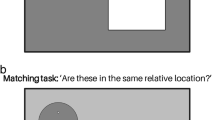Abstract
Studies of spatial representation generally focus on flat environments and visual stimuli. However, the world is not flat, and slopes are part of many natural environments. In a series of four experiments, we examined whether humans can use a slope as a source of allocentric, directional information for reorientation. A target was hidden in a corner of a square, featureless enclosure tilted at a 5° angle. Finding it required using the vestibular, kinesthetic and visual cues associated with the slope gradient. Participants succeeded in the task; however, a large sex difference emerged. Men showed a greater ability in using slope and a greater preference for relying on slope as a searching strategy. The female disadvantage was not due to wearing heeled shoes, but was probably related to a greater difficulty in extracting the vertical axis of the slope.
Access this chapter
Tax calculation will be finalised at checkout
Purchases are for personal use only
Preview
Unable to display preview. Download preview PDF.
Similar content being viewed by others
References
Cheng, K.: A purely geometric module in the rat’s spatial representation. Cognition 23, 149–178 (1986)
Proffitt, D.R., Bhalla, M., Gossweiler, M., Midgett, J.: Perciving geographical slant. Psychonomic Bulletin & Review 2, 409–428 (1995)
Restat, J.D., Steck, S.D., Mochnatzki, H.F., Mallot, H.A.: Geographical slant facilitates navigation and orientation in virtual environments. Perception 33, 667–687 (2004)
Miniaci, M.C., Scotto, P., Bures, J.: Place navigation in rats guided by a vestibular and kinesthetic orienting gradient. Behavioural Neuroscience 113, 1115–1126 (1999)
Nardi, D., Bingman, V.P.: Pigeon (Columba livia) encoding of a goal location: The relative importance of shape geometry and slope information. Journal of Comparative Psychology 123, 204–216 (2009)
Nardi, D., Bingman, V.P.: Slope-based encoding of a goal location is unaffected by hippocampal lesions in homing pigeons (Columba livia). Behavioral Brain Research 205, 322–326 (2009)
Strasser, R., Bingman, V.P.: Goal recognition and hippocampal formation in the homing pigeon (Columba livia). Behav. Neurosci. 111, 1245–1256 (1997)
Vargas, J.P., Petruso, E.J., Bingman, V.P.: Hippocampal formation is required for geometric navigation in pigeons. European Journal of Neuroscience 20, 1937–1944 (2004)
Nardi, D., Nitsch, K.P., Bingman, V.P.: Slope-Driven Goal Location Behavior in Pigeons. Journal of Experimental Psychology: Animal Behavior Processes (in press)
Sturzl, W., Cheung, A., Cheng, K., Zeil, W.: The information content of panoramic images I: The rotational errors and the similarity of views in rectangular experimental arenas. Journal of Experimental Psychology: Animal Behavior Processes 34, 1–14 (2008)
Chai, X.J., Jacobs, L.F.: Sex difference in directional cue use in a virtual landscape. Behavioral Neuroscience 123, 276–283 (2009)
Voyer, D., Voyer, S., Bryden, M.P.: Magnitude of sex differences in spatial abilities: A meta-analysis and consideration of critical variables. Psychological Bulletin 117, 250–270 (1995)
Kelly, D.M., Bischof, W.F.: Reorienting in images of a three-dimensional environment. Journal of Experimental Psychology: Human Perception and Performance 31, 1391–1403 (2005)
Lawton, C.A., Charleston, S.I., Zieles, A.S.: Individual- and gender-related differences in indoor wayfinding. Environment and Behavior 28, 204–219 (1996)
Sandstrom, N.J., Kaufman, J., Huettel, S.A.: Males and females use different distal cues in a virtual environment navigation task. Cognitive Brain Research 6, 351–360 (1998)
Franklin, N., Tversky, B.: Searching imagined environments. Journal of Experimental Psychology: General 119, 63–76 (1990)
Alvis, G.R., Ward, J.R., Dodson, D.L.: Equivalence of male and female performance on a tactuo-spatial maze. Bulletin of the Psychonomic Society 27, 29–30 (1989)
Walker, J.T.: Tactual field dependence. Psychonomic Science 26, 311–313 (1972)
Berthiaume, F., Robert, M., St-Onge, R., Pelletier, J.: Absence of a gender difference in a haptic version of the water-level task. Bulletin of the Psychonomic Society 31, 57–60 (1993)
Jacobs, L.F., Schenk, F.: Unpacking the cognitive map: The parallel map theory of hippocampal function. Psychological Review 110, 285–315 (2003)
Author information
Authors and Affiliations
Editor information
Editors and Affiliations
Rights and permissions
Copyright information
© 2010 Springer-Verlag Berlin Heidelberg
About this paper
Cite this paper
Nardi, D., Newcombe, N.S., Shipley, T.F. (2010). The Role of Slope in Human Reorientation. In: Hölscher, C., Shipley, T.F., Olivetti Belardinelli, M., Bateman, J.A., Newcombe, N.S. (eds) Spatial Cognition VII. Spatial Cognition 2010. Lecture Notes in Computer Science(), vol 6222. Springer, Berlin, Heidelberg. https://doi.org/10.1007/978-3-642-14749-4_6
Download citation
DOI: https://doi.org/10.1007/978-3-642-14749-4_6
Publisher Name: Springer, Berlin, Heidelberg
Print ISBN: 978-3-642-14748-7
Online ISBN: 978-3-642-14749-4
eBook Packages: Computer ScienceComputer Science (R0)




